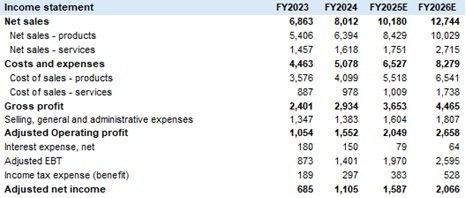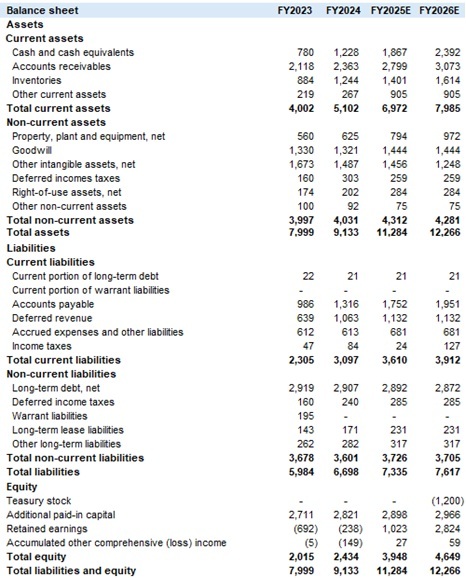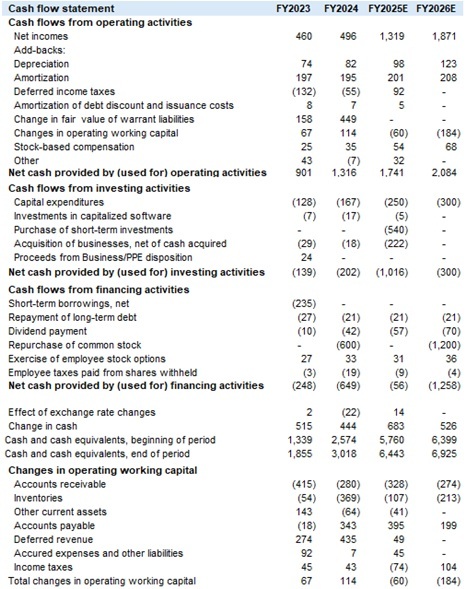-
Products
- Local Securities
- China Connect
- Grade Based Margin
- Stock Borrowing & Lending
- IPO
- Stock Options
- Foreign Stocks
- Unit Trust
- Local Futures
- Foreign Futures
- Forex
- Bullion
- Insurance Services
- Bond
- Monthly Investment Plan
- Mortgage
- Other Services
- Surplus Cash Facility
- Phillip Premier
- Latest Insurance Promotion<
- Smart Minor (Joint) Account
- ETF
- Capital Management
- Research
- Market Info
- Education Center
- Phillip Apps
- Customer Service
- About Us
-
Surplus Cash Facility
Research Report
Vertiv (VRT.US) - Liquid Cooling Technology Presents New Growth Opportunities
Friday, November 21, 2025  93
93
Vertiv
| Recommendation | Accumulate |
Weekly Special - 3606 Fuyao Glass
Company background
Vertiv (VRT) designs, manufactures and services critical digital infrastructure for data centers (80% of net sales in 2024), communication networks (10%), and commercial and industrials (10%). Key products include critical infrastructure & solutions (AC & DC power management, integrated modular solutions, thermal management), integrated rack solutions (racks, rack power and power distribution, rack power distribution etc.), and management systems for monitoring and controlling digital infrastructure, integral to the technologies in services such as e-commerce, online banking, file sharing, video on-demand, energy storage, wireless communications, IoT and online gaming. The most prominent brands include Vertiv, Liebert, NetSure, Geist, Energy Labs, ERS, Albér, and Avocent. The company operates across three reportable segments: the Americas (56% of net sales in 2024); Asia Pacific (22%); and Europe, Middle East, & Africa (22%).
Industry overview
VRT is operating in the data center infrastructure industry, a core sector supporting global digital transformation, primarily providing hardware facilities and technical services required for data storage, computation, and transmission in fields like the internet, cloud computing, and AI. The industry primarily generates revenue through the sale of key data center equipment, including power systems (e.g., 800VDC platform), cooling equipment (e.g., liquid cooling CDU units), server racks, and IT infrastructure. Taking VRT as an example, its 3Q25 revenue reached $2,676mn (82.8% of product sales), driven mainly by explosive demand from AI data centers for liquid cooling solutions and high-efficiency power products. VRT's role as the exclusive liquid cooling supplier in the NVIDIA-led COOLERCHIPS program further validates the profit potential of high value-added products.Capital expenditure by hyperscale operators and data centers grew by 55% in 2024 and is expected to increase by a further 56% in 2025. However, Vertiv's organic sales grew by only 18% in 2024, with projected growth of 26-28% in 2025. This indicates that the company is struggling to fully meet the surging market demand due to factors such as supply chain constraints and the typical positioning of cooling solutions later in the procurement cycle. As the backlog of unfilled orders continues to rise and stable capital expenditure supports the growth trajectory, the company's order volume continues to increase. Given that organic order volume is a core revenue driver, we forecast net sales growth of 27%/25% in 2025/2026 under the baseline scenario.According to Dell'Oro Group data, the liquid cooling market size is expected to approach $2 billion by 2027, with a compound annual growth rate of 60% during the period 2020-2027. The upgrade in cooling technology requires driving product structure optimization, allowing Vertiv to strengthen its pricing power and improve gross margins. However, the full manifestation of this effect depends on the pace of technological evolution, so its impact is relatively limited in the 2026 forecast. The breakthrough in microfluidics technology announced by Microsoft in September, which embeds liquid cooling directly inside chips, makes precise control of liquid flow paths within racks crucial. Amid the growing trend of hyperscale operators emphasizing independent intellectual property development, the company, with its unique positioning, can seize such high-value innovation opportunities and continue to serve as a core partner for the development, supply, and deployment of large-scale solutions.
Company valuation
Data centers are placing higher demands on cooling solutions to support continuously increasing rack power densities. Current data centers commonly support rack power exceeding 20kW, but the market is moving towards levels above 50kW. The thermal density characteristics of new-generation CPUs and GPUs significantly exceed those of previous generations, while server manufacturers are packing more processing units into individual racks to meet the surging demands of high-performance computing and AI applications.Although the growth in order volume has been accompanied by a narrowing incremental profit margin, reflecting a weakening pricing power since the second quarter of 2024, signs of easing pressure have emerged. In the third quarter of 2025, the Americas region contributed 40% of the incremental operating profit margin, marking a strong reversal from the declining trend in incremental margins in the first half of the year. This was primarily due to the fading impact of raw material costs and tariffs. Management expects to largely offset the tariff impacts by the end of the first quarter of 2026. Accordingly, we set the incremental operating profit margin for the baseline 2025/2026 scenario at 23%/24%.Key assumptions in the DCF analysis:1. WACC: The capital structure consists of 67.6% debt and 32.4% equity, with a debt cost of 1.2%, an effective tax rate of 35.2%, and an equity cost of 27.2%.2. The discount period is from the fourth quarter of 2025 to the fourth quarter of 2026, calculated on a quarterly basis.3. The perpetual growth rate is 4.0%, based on the US GDP growth rate, converted to a quarterly growth rate of 1.0%.Considering the limitations of the DCF model, we employed three valuation methods, comparing this result with EV/EBIT and P/E valuations, and ultimately derived a target price of $188, initiating with an "Accumulate" rating.

Risk factors
1) Intensifying competition;
2) Intensified trade friction;
3) Deteriorated market demand.
Financials



Current Price as of: Nov 19
Source: PSHK Est.
This report is produced and is being distributed in Hong Kong by Phillip Securities Group with the Securities and Futures Commission (“SFC”) licence under Phillip Securities (HK) LTD and/ or Phillip Commodities (HK) LTD (“Phillip”). Information contained herein is based on sources that Phillip believed to be accurate. Phillip does not bear responsibility for any loss occasioned by reliance placed upon the contents hereof. The information is for informative purposes only and is not intended to or create/induce the creation of any binding legal relations. The information provided do not constitute investment advice, solicitation, purchase or sell any investment product(s). Investments are subject to investment risks including possible loss of the principal amount invested. You should refer to your Financial Advisor for investment advice based on your investment experience, financial situation, any of your particular needs and risk preference. For details of different product's risks, please visit the Risk Disclosures Statement on http://www.phillip.com.hk. Phillip (or employees) may have positions/ interests in relevant investment products. Phillip (or one of its affiliates) may from time to time provide services for, or solicit services or other business from, any company mentioned in this report. The above information is owned by Phillip and protected by copyright and intellectual property Laws. It may not be reproduced, distributed or published for any purpose without prior written consent from Phillip.
Top of Page
|
Please contact your account executive or call us now. Research Department Tel : (852) 2277 6846 Fax : (852) 2277 6565 Email : businessenquiry@phillip.com.hk Enquiry & Support Branches The Complaint Procedures |
About Us Phillip Securities Group Join Us Phillip Network Phillip Post Phillip Channel Latest Promotion 新闻稿 |
E-Check Login |
Investor Notes Free Subscribe |

|




